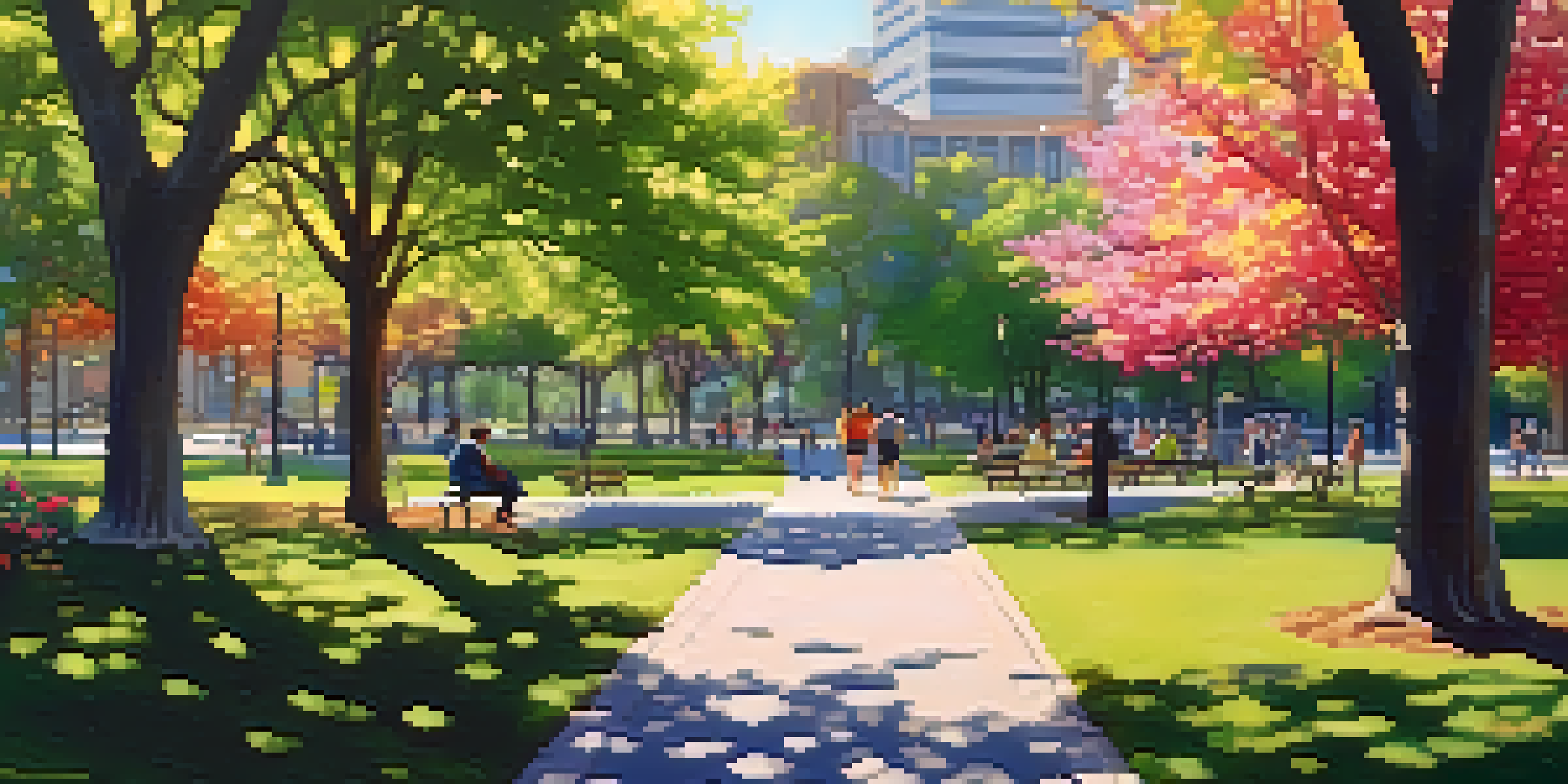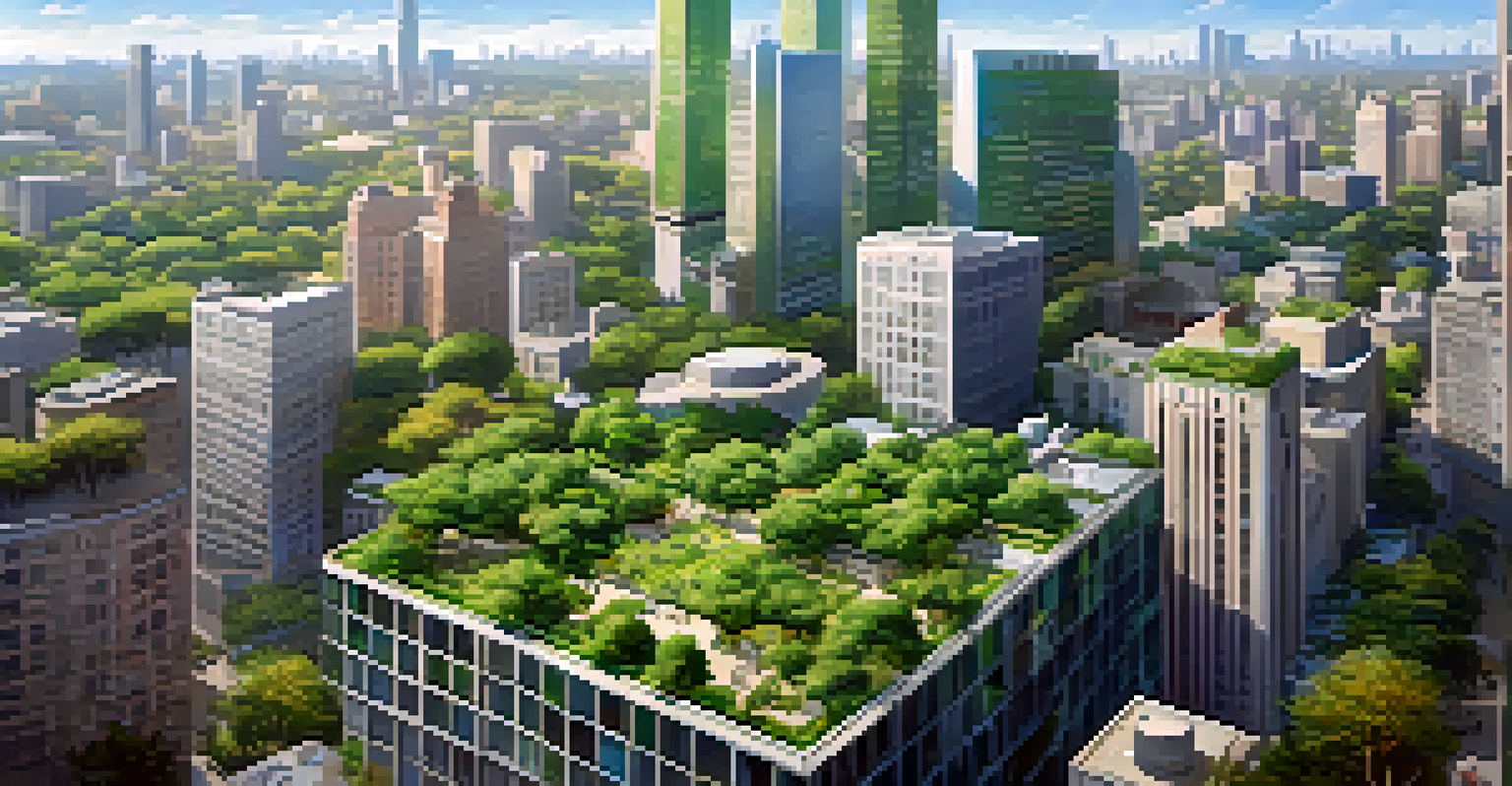The Benefits of Urban Forestry for Community Well-being

Understanding Urban Forestry and Its Importance
Urban forestry refers to the management and care of trees in urban areas. This practice not only beautifies cities but also plays a crucial role in enhancing the quality of life for residents. With the rise of urbanization, the integration of green spaces has become increasingly vital for sustainable living.
The best time to plant a tree was twenty years ago. The second best time is now.
Trees and green spaces provide a counterbalance to the concrete and asphalt of urban environments. They contribute to cleaner air, improved aesthetics, and greater biodiversity. Recognizing the importance of urban forestry helps communities appreciate their green resources and encourages involvement in local initiatives.
Moreover, urban forestry acts as a bridge between nature and urban life, fostering a sense of connection. When communities engage with their natural surroundings, they cultivate a deeper appreciation for environmental stewardship, creating a healthier ecosystem for all.
Enhancing Mental Health Through Green Spaces
Numerous studies have shown that spending time in nature can significantly improve mental health. Urban forests offer a tranquil escape from the hustle and bustle of city life, allowing individuals to relax and recharge. This connection to nature can reduce stress, anxiety, and even symptoms of depression.

By providing spaces for leisure and reflection, urban forests encourage mindfulness and promote a sense of well-being. Whether it’s a stroll through a park or simply sitting under a tree, these experiences can be profoundly restorative. The presence of greenery in urban settings directly correlates with improved mood and emotional health.
Urban Forestry Enhances Well-Being
Green spaces in urban areas significantly improve mental health by providing tranquil environments for relaxation and social interaction.
Additionally, community gardens and green spaces serve as social hubs, where residents can gather and connect. This interaction fosters a sense of belonging, which is crucial for mental health. Overall, enhancing access to urban forestry can lead to healthier, happier communities.
Improving Air Quality and Public Health
Trees play a pivotal role in improving air quality by absorbing pollutants and producing oxygen. Urban areas often grapple with poor air quality, which can lead to respiratory issues and other health problems. By increasing the number of trees in cities, we can mitigate these health risks.
Trees are the earth's endless effort to speak to the listening heaven.
Moreover, urban forests can help lower temperatures through shade and evapotranspiration, creating a cooler environment. This is especially important during heatwaves, where extreme temperatures can be dangerous, particularly for vulnerable populations. Green spaces act as natural air conditioners, enhancing public health.
The presence of trees and greenery also encourages physical activity, as people are more likely to walk, jog, or cycle in appealing environments. This increased activity level contributes to better overall health and well-being, reducing the burden on healthcare systems. Investing in urban forestry is, therefore, an investment in community health.
Fostering Biodiversity in Urban Areas
Urban forestry plays a critical role in fostering biodiversity, providing habitats for various species. Trees and green spaces create ecosystems that support birds, insects, and other wildlife, even in densely populated areas. This biodiversity is essential for maintaining ecological balance.
Additionally, urban forests can serve as corridors for wildlife, allowing species to thrive despite urban challenges. By planting diverse tree species, communities can ensure a resilient urban ecosystem that can adapt to changing environmental conditions. This not only benefits wildlife but enriches human experience in urban settings.
Trees Improve Air Quality
Urban forests play a crucial role in enhancing air quality by absorbing pollutants and providing oxygen, which benefits public health.
Encouraging biodiversity through urban forestry also helps combat the effects of climate change. Trees absorb carbon dioxide and mitigate urban heat, contributing to a healthier planet. In this way, urban forests are not just beneficial for local communities, but for the global environment as well.
Economic Benefits of Urban Forestry
Investing in urban forestry can lead to significant economic benefits for communities. Green spaces can increase property values, making neighborhoods more desirable. Homebuyers often prioritize access to parks and trees, which can drive up real estate prices and stimulate local economies.
Moreover, urban forestry can reduce costs associated with stormwater management. Trees absorb rainwater, decreasing runoff and minimizing the need for extensive drainage systems. This not only saves municipalities money but also protects local waterways from pollution.
Finally, urban forests can boost tourism and recreational opportunities, attracting visitors to parks and natural attractions. This influx can stimulate local businesses and create jobs, contributing to a vibrant community economy. The economic advantages of urban forestry are a compelling reason for cities to prioritize green initiatives.
Creating Community Spaces for Social Interaction
Urban forests and green spaces serve as essential gathering places for community interaction. Parks, gardens, and tree-lined streets encourage social activities and events, fostering a sense of community. These spaces provide opportunities for individuals to come together, share experiences, and build relationships.
Additionally, well-maintained green spaces can host community events, such as farmers' markets, concerts, and festivals. These gatherings not only enhance community spirit but also promote local culture and economy. When residents engage in these activities, it strengthens their connection to one another and to their environment.
Community Engagement is Key
Involving residents in urban forestry initiatives fosters a sense of ownership and strengthens community bonds.
Furthermore, urban forestry initiatives often involve community members in planning and maintenance. This involvement empowers residents, making them stewards of their neighborhoods. By participating in the care of local green spaces, individuals develop a sense of pride and ownership, reinforcing community ties.
Climate Resilience Through Urban Forestry
Urban forestry contributes significantly to climate resilience, helping cities adapt to climate change. Trees provide shade, reduce heat, and help manage stormwater, making urban areas less vulnerable to extreme weather events. By integrating green infrastructure, communities can better withstand the impacts of climate change.
Moreover, trees play a vital role in carbon sequestration, absorbing carbon dioxide from the atmosphere. This process helps mitigate the effects of climate change, making urban forestry a key player in environmental sustainability. As cities grow, the need for these green solutions becomes increasingly urgent.

Incorporating urban forestry into city planning not only enhances resilience but also promotes a culture of sustainability. When communities prioritize green initiatives, they inspire future generations to value and protect their environment. The long-term benefits of urban forestry extend far beyond immediate gains, ensuring a healthier planet for all.
Engaging Communities in Urban Forestry Initiatives
Community engagement is crucial for the success of urban forestry initiatives. By involving residents in tree planting and maintenance programs, cities can foster a sense of ownership and responsibility. This participation not only enhances the effectiveness of these initiatives but also strengthens community bonds.
Educational programs can empower residents with knowledge about the benefits of urban forestry. Workshops, volunteer days, and school programs can teach individuals how to care for trees and green spaces. When people understand the value of their natural surroundings, they are more likely to advocate for their protection and expansion.
Additionally, partnerships between local governments, non-profits, and community organizations can amplify the impact of urban forestry efforts. Collaborative projects can mobilize resources and expertise, ensuring the sustainability of green initiatives. By working together, communities can create thriving urban forests that benefit everyone.